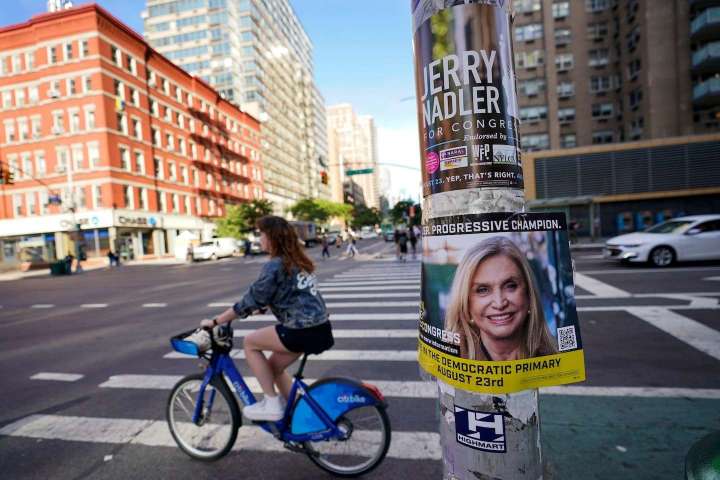New York’s primaries were supposed to be over months ago.
New York’s chaotic Democratic primaries, explained

“Democrats thought they would be able to count on New York more than we might be able to produce for the party,” said Basil Smikle, the former executive director of the New York State Democratic Party. “It’s possible that one or two legislative legends will lose their seat.”
Here’s what’s going on.
The background: Democrats overstepped on redistricting
This spring, New York Democrats actually had a chance to steer redistricting in their favor. They initially approved district lines that favored them in all but a few of the state’s 26 congressional districts and could win them up to three new seats. Then New York’s top court threw out the map, saying it was an illegal gerrymander.
“The legislature overplayed their hand, and Republicans sued and won,” said Smikle. “It was a huge victory for Republicans in the state.”
The new, court-approved maps are “are among the most competitive and politically balanced in the nation,” according to a Brennan Center analysis, which notes that New York is one of very few states that got more — rather than less — competitive after redistricting.
The state’s new congressional lines are drawn with little regard for how Democrats can keep their House majority. Because no Democrat in their right mind would engineer the match-ups that they have to deal with Tuesday.
1. Two committee chairs have to face off for one district
Democratic Reps. Carolyn Maloney and Jerrold Nadler are two of the most well-known names in Congress. Nadler took a prominent role in Trump’s two impeachments as the chair of the House Judiciary Committee. And Maloney is chair of the House Oversight Committee, which started an investigation this winter into what Trump took to Mar-a-Lago.
Both have been in Congress for 30 years, comfortably seated next to each other. But the new maps combined their wealthy Manhattan districts, so that only one can stay in Congress. Either could have moved districts, but both decided to stay and duke it out.
A 38-year-old lawyer, Suraj Patel, is also challenging the two veteran lawmakers, hoping to crank up the enthusiasm among younger voters in the district. In a recent debate, he was the only candidate to express support for president Biden seeking reelection. After taking some heat for her comments, Maloney said on national television, “Mr. President, I apologize. I want you to run.”
The race has quickly become a competition over identity politics.
Maloney is leaning hard into her gender and her reputation as a groundbreaker for women in politics: “You cannot send a man to do a woman’s job,” she says in a TV ad. “Of all the things I’ve worked on, it’s hardest to move things forward for women,” Maloney told The Post’s Colby Itkowitz at a recent campaign stop.
Nadler, meanwhile, has highlighted in his fundraising messages that he’s New York City’s last Jewish congressman. Earlier this year, he told The Washington Post, “It would be very unfortunate if there was no Jewish representation from New York.”
2. The head of House Democrats’ campaign arm is in the crosshairs of progressives
The new maps shook up another powerful House Democrat, Rep. Sean Patrick Maloney (no relation to Rep. Carolyn Maloney). He’s in charge of House Democrats’ campaign arm this year — a tough job, since the party in power in Washington almost always loses seats in Congress in midterm elections.
Adding to his troubles, the district he’s represented for nine years, outside New York City, became a lot more competitive. So he decided to run for reelection in a more Democratic district nearby. (In addition to self-preservation, Maloney was likely aware of the added embarrassment Democrats would face if, on top of losing the House, their campaign head lost his seat.)
But in doing so, Maloney, who is a White man, set himself up to challenge a gay, Black freshman member of Congress who already represented much of the area — Rep. Mondaire Jones. Liberals accused Maloney’s circle of “thinly veiled racism” for suggesting Jones might be better-suited for a different district. Rep. Alexandria Ocasio-Cortez (D-N.Y.) even said Maloney should resign from his role as head of Democrats’ campaign arm if he was going to challenge another member of the party.
In the end, Maloney “successfully bullied” Jones to run in another district, as David Wasserman at Cook Political Report describes it. And Ocasio-Cortez has lent her considerable weight to another challenger to Maloney, state Sen. Alessandra Biaggi.
New York observers think Maloney will win Tuesday’s primary, but he’s not out of the woods yet. This district is more Democratic-leaning than his old one, but it could still flip in a good election year for Republicans — and that would make Maloney one of the party’s highest-profile losses in November.
3. A diverse Manhattan district with an open seat
Jones, the congressman pushed out of the district Maloney is running in, is far from certain to stay in Congress. Rather than run against an incumbent, he is competing for a rare open seat representing New York’s 10th district deep in Manhattan, covering Chinatown to Wall Street to the Lower East Side and parts of Brooklyn. (This is the district Nadler left after it was redrawn, if you’re keeping track.)
Speaker Nancy Pelosi (D-Calif.) has endorsed him. But it’s a crowded field: A huge group of Democrats are also running. They include former House impeachment lawyer Daniel Goldman (who got the New York Times’ endorsement, sparking some criticism that the paper backed a White man in a diverse district); a state assemblywoman, Yuh-Line Niou (who points out the new district actually includes two Chinatowns); and New York City councilwoman Carlina Rivera, who has more endorsements than the rest of the field.






